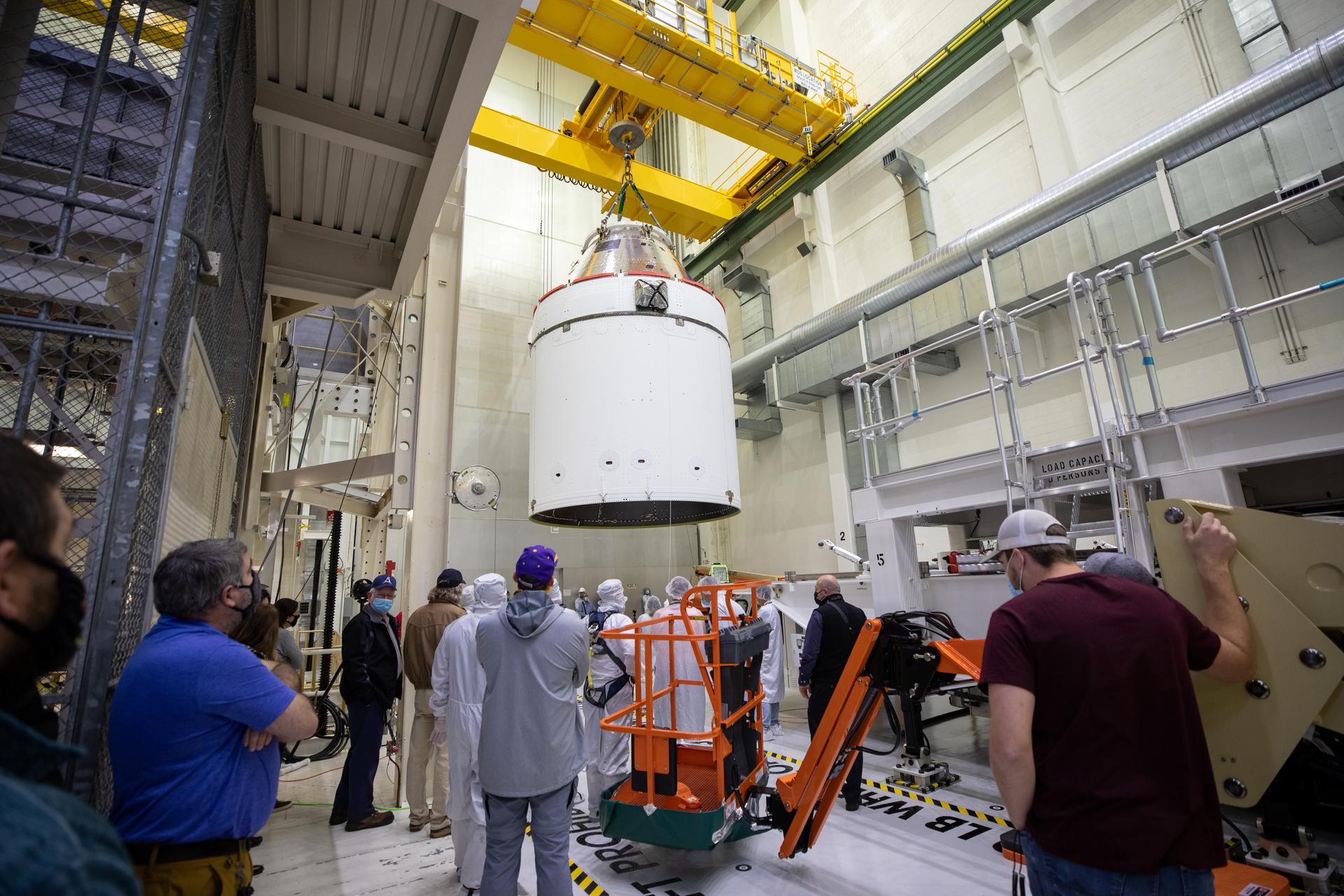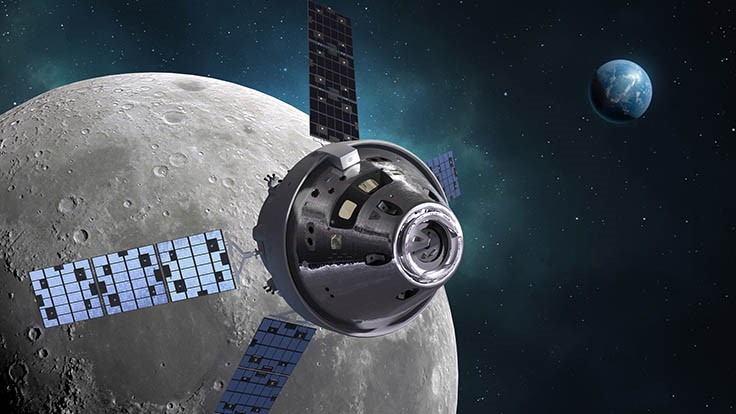With NASA gearing up for its upcoming mission to the Moon, 2021 will be a big year for space news. Ramping up its ambitious plans to return humans to the lunar surface, the U.S. space agency handed over its fully assembled Orion space capsule to another facility for launch processing. In 2018, we learned that the Orion crew and service module, developed for the un-crewed Artemis I mission expected to launch later this year, used 100 3D printed parts. Like many space startups and large aerospace companies, Orion Program’s lead contractor, Lockheed Martin, has been using additive manufacturing technologies exponentially to build the capsule.
NASA’s next-generation Orion spacecraft is built to take humans farther than they have ever gone before, including to the Moon and Mars. Artemis I will be the first integrated test of NASA’s Orion spacecraft and its launch system, the new heavy-lift Space Launch System (SLS), the most powerful rocket ever built. The un-crewed flight test will provide a foundation for human deep space exploration as it travels 280,000 miles from Earth for a three-week mission. Once the un-crewed Artemis I mission is complete, Orion will serve as the exploration vehicle that will carry the first crew to space during the subsequent Artemis II and III missions, set to start launching in 2024. It will also provide emergency abort capability, sustain the crew during space travel, and provide safe re-entry from deep space return velocities.
In preparation for this flight, NASA revealed Orion as it was readied atop a transport pallet from the Neil Armstrong Operations and Checkout Building (O&C Building) at the Kennedy Space Center in Florida, where engineers have meticulously outfitted it with thousands of components and tested its systems and subsystems to ensure it can accomplish its mission. On January 16, 2021, the spacecraft was moved from the spaceport’s O&C Building to the Multi-Payload Processing Facility (MPPF), also at Kennedy, to begin ground processing by NASA’s Exploration Ground Systems (EGS) team.
After a ride onboard the transporter, NASA said that Orion would be moved onto a service stand that provides 360-degree access, allowing engineers and technicians from EGS, its prime contractor Jacobs Technology, and other support organizations fuel and service the spacecraft. It will go through multiple Kennedy facilities where EGS will load propellants and other consumables such as ammonia, helium, and nitrogen onboard and integrate the launch abort system and protective ogive fairing. Once completed, Orion will be taken to the Vertical Assembly Facility to be lifted onto the SLS rocket and prepared for roll to the launch pad.
“Orion is a unique and impressive spacecraft, and the team did an outstanding job to get us to this day,” said Mike Hawes, Orion vice president and program manager for Lockheed Martin. “The launch and flight of Artemis I will be an impressive sight, but more importantly, it will confirm Orion is ready to carry humans to the Moon and back home safely. This tremendous advancement opens the door to a new era of deep space exploration that will ultimately benefit us back here on Earth.”

Orion processing team members view Orion as a crane moves it to its transport pallet inside the Neil Armstrong Operations and Checkout Building at NASA’s Kennedy Space Center in Florida. Image courtesy of NASA/Ben Smegelsky.
NASA has incorporated advanced manufacturing techniques, like 3D printing, onboard both the rocket and spacecraft. In 2006, the agency selected Lockheed to design, develop, and build Orion. Company engineers teamed up with Stratasys to create parts for Orion, which resulted in over 100 parts custom created for the capsule, such as a 3D printed hatch door built entirely of Antero (ESD) – a Stratasys PEKK-based high-performance polymer designed to withstand the extreme heat of space travel.
Lockheed is already working on other Orion crew modules and service module adapters for the manned Artemis II mission. Both are well under assembly at Kennedy and will see the first power-on of its integrated computers this summer. For these upcoming spacecraft, Lockheed is developing close to 200 3D printed parts. During a 2019 interview with Lockheed Martin Space specialists Brian Kaplun, Manager of the Additive Manufacturing Lab, and Colin Sipe, Orion Crew Systems Senior Manager, 3DPrint.com, found out that the engineers manufacture a lot of parts that would be traditionally difficult to produce, such as mass optimized structural brackets and tubing to channel airflow throughout the crew cabin. They even 3D printed different spacers (parts that go between the edge of the seat and the astronaut’s hip) for the astronauts’ Orion.
Orion’s formal transition from manufacturing and assembly into flight processing might have helped increase confidence in the approaching November 2021 launch date. However, during the critical Green Run test of the SLS core stage, a separate engine problem could change Artemis I mission plans. Space undertakings are commonly delayed due to spacecraft assembly issues, test failures on the ground, and, in 2020, the adverse impact of the COVID-19 pandemic. Even the launch date for the Artemis I mission has been delayed several times. Originally set to leave Earth in 2017, the date did not hold, and the maiden launch for the SLS was subsequently further delayed. We still don’t know for sure whether Artemis I will take off in 2021 or 2022. But, one thing is for sure, the Orion team persevered through design, production, and test challenges, to transform tens of thousands of individual parts into an integrated and functional spacecraft, ready to begin the future of space exploration.
Subscribe to Our Email Newsletter
Stay up-to-date on all the latest news from the 3D printing industry and receive information and offers from third party vendors.
You May Also Like
Gorilla Sports GE’s First 3D Printed Titanium Cast
How do you help a gorilla with a broken arm? Sounds like the start of a bad joke a zookeeper might tell, but it’s an actual dilemma recently faced by...
Nylon 3D Printed Parts Made More Functional with Coatings & Colors
Parts 3D printed from polyamide (PA, Nylon) 12 using powder bed fusion (PBF) are a mainstay in the additive manufacturing (AM) industry. While post-finishing processes have improved the porosity of...
$25M to Back Sintavia’s Largest Expansion of Metal 3D Printing Capacity Since 2019
Sintavia, the digital manufacturing company specializing in mission-critical parts for strategic sectors, announced a $25 million investment to increase its production capacity, the largest expansion to its operations since 2019....
Velo3D Initiates Public Offering in a Bid to Strengthen Financial Foundations and Drive Future Growth
Velo3D (NYSE: VLD) has been among a number of publicly traded 3D printing firms that have attempted to weather the current macroeconomic climate. After posting a challenging financial report for 2023,...































